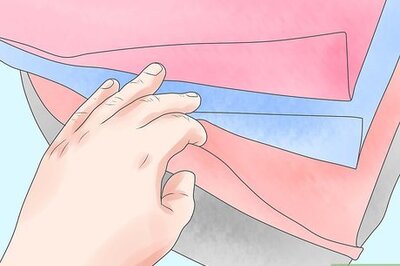
views
As 59 seats in Uttar Pradesh go to polls in phase four, the Bharatiya Janata Party (BJP) is looking to defend its stronghold, even as the Samajwadi Party (SP) attempts to breach it.
The fate of 172 assembly seats has been decided in the earlier three phases.
In 2017, the BJP had won 50 of the 59 seats spread across the regions of Awadh, Rohelkhand and Bundelkhand, one seat was won by BJP ally Apna Dal, four by SP and two each by the Congress and the Bahujan Samaj Party (BSP).
The nine districts going to polls in this phase are Pilibhit and Lakhimpur Kheri in Terai belt of Rohelkhand, Sitapur, Hardoi, Unnao, Lucknow, Rae Bareli and Fatehpur in Awadh and Banda in Bundelkhand. The region that is now a BJP citadel was nearly without saffron in 2012. Then the Samajwadi party had won 39 seats, 12 had gone to the BSP and BJP could win just four. Three seats were won by the Congress, including that of Rae Bareli by Aditi Singh. She is again in the contest, but on a BJP ticket.
In phase four, the regions are not defined by any dominant narrative, unlike phase one and two where Jat and Muslim equations were the biggest factors or phase three where large pockets were traditional Yadav strongholds. The regions in phase four have often seen a swing. In 2007, when the BSP had formed the government in the state, it too had done significantly well in the region. The same was the case in 2012.
The 59 assembly seats going to polls in the fourth phase are Pilibhit, Barkheda, Puranpur (SC), Bisalpur, Palia, Nighasan, Gola Gokarnath, Srinagar (SC), Dhaurhara, Lakhimpur, Kasta (SC), Mohammadi, Maholi, Sitapur, Hargaon (SC), Laharpur, Biswan, Sevata, Mahmudabad, Sidhauli (SC),Misrikh (SC), Sawaijpur, Shahabad, Hardoi, Gopamau (SC), Sandi (SC), Bilgram-Mallanwa, Balamau (SC), Sandila, Bangarmau, Safipur (SC), Mohan (SC), Unnao, Bhagwantnagar, Purva, Malihabad (SC), Bakshi Ka Talab, Sarojininagar, Lucknow West, Lucknow North, Lucknow East,Lucknow Central, Lucknow Cantonment, Mohanlalganj (SC), Bachhrawan (SC) , Harchandpur, Rae Bareli, Sareni, Unch Shahar, Tindwari, Baberu, Naraini (SC), Banda, Jehanabad, Bindki, Fatehpur, Ayahshah, Hussainganj and Khaga (SC).
CAN LAKHIMPUR VIOLENCE IMPACT THE RESULTS?
The biggest controversy that had put the BJP on the defensive and even looked to have derailed the party’s campaign blitzkrieg was the alleged mowing down of farmers by Ashish Mishra, son of Union minister of state for home Ajay Mishra Tenni. The incident that happened last October gave the Opposition the much-needed moment to launch a mega counter-offensive against the ruling BJP.
The region is a significant sugarcane belt in central UP and has a strong presence of Sikh voters as well.
So can the Opposition hope for an electoral success in the farmers’ belt of Lakhimpur and Pilibhit? Or will the “outsider versus locals” narrative against the big landholding Sikh farming community help the BJP navigate through the troubled waters?
Like phase three, eyes will also be on the voting pattern of the most backward castes (MBCs) and Dalits. The castes also converge with the new beneficiary class of “Labharthies”, which the BJP claims it has created through successful implementation of its welfare schemes, especially free ration through both central and state quota. In 2017, the BJP had won all eight seats in Lakhimpur and also all four in Pilibhit.
FROM RAJNATH’S TURF TO SONIA’S BASTION
The BJP also faces the challenge of defending the long-standing electoral fort of Lucknow. The parliamentary constituency, which is is still remembered as the “karmbhoomi” of former Prime Minister the late Atal Bihari Vajpayee. Although the BJP has never lost the Lucknow Parliamentary seat for more than three decades, with Union defence Minister Rajnath Singh being the incumbent Member of Parliament from the city of Nawabs, it has often been a challenging contest.
The BJP had won eight of the nine seats from Lucknow in 2017. In 2012, the Samajwadi Party had won seven seats. Two cabinet ministers ? Brijesh Pathak and Ashutosh Tandon ? are in the electoral race. After denying ticket to sitting minister Swati Singh, the BJP is trying to fight the anti-incumbency by fielding cop-turned-politician Rajeshwar Singh from Sarojini Nagar. The SP is expected to give a tough fight on a few urban seats as well as rural seats of Bakshi ka talab, Mohanlalganj and Malihabad.
In neighboring Rae Bareli, the last standing stronghold of the Congress, the BJP will hope to strengthen its footprint. In 2017, despite the saffron wave, the party had won just two of the five seats in the district. Two were won by the Congress and one by the SP. With Aditi Singh’s entry into the party fold, the BJP hopes the lotus will bloom on Rae Bareli Sadar assembly seat for the first time ever.
For Congress’s Priyanka Gandhi, saving the party stronghold and her mother Sonia Gandhi’s parliamentary constituency will surely be a prestige issue. Priyanka extensively campaigned in the district for two days. The results here will also be read in the larger context of the “Congress story in UP”.
THE MBC AND MAHA DALIT FACTOR
As the polls are in the middle of the seven-phase elections, the most crucial aspect, like that of phase three, will be the voting pattern of the MBCs and the non-Jatav Dalit communities. With three phases of polling, there is increasing clarity about the voting choices of key castes and communities, namely the Jats, Muslims, Yadavs, upper castes, including Brahmins, and Jatavs among the Dalits.
However, the most backward castes and non-Jatav Dalits are seen as big fence-sitters. It is this big voting block that also constitutes the bulk of the economically poor class that has clearly endorsed the BJP in 2017. The support of the MBCs and Dalits, along with the upper caste, was the reason behind the BJP’s phenomenal 40% vote share in the last assembly elections.
Talking of phase four, in 2017, the BJP had won seven of the eight seats in Hardoi, seven of the nine seats in Sitapur, all four in Banda, five of the six seats in Unnao and all the six seats in Fatehpur. In 2012, the SP and BSP had done better in these districts.
This time around, the SP hopes the issues of stray cattle, price rise, unemployment and alleged neglect of the OBCs under the chief minister of upper caste Yogi Adityanath will ensure the needed shift of these castes in its favour.
The BJP, on the other hand, thinks its honest implementation of welfare schemes such as housing for the poor and free ration, along with the larger political narrative of law and order and domination of a particular caste associated with the SP, will act as the needed check against any possible exodus. The BJP’s high-pitch campaign on the issue of terrorism and “tamanchawadi”, a charge against the SP, is an effort to strengthen this narrative.
Read all the Latest Politics News and Breaking News here




















Comments
0 comment